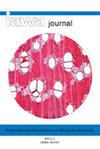用于研究木质部结构与功能关系的无孔管状元分类
IF 3.5
3区 农林科学
Q2 FORESTRY
引用次数: 2
摘要
发现木质部功能是如何从木质部结构中显现出来的,需要不同于为木材鉴定而发明的方法。我通过讨论无孔管胞元素的分类来说明对不同方法的需求,这些细胞的名称为“纤维”、管胞、纤维管胞和自由纤维。目前,有两个分类系统,一个用于木材鉴定,另一个由Sherwin Carlquist倡导用于木质部功能研究。我强调,两者都不适用于所有应用程序,但都适合其领域的目标。木材鉴定使用了一种易于应用的无孔气管元素分类,旨在长期保持稳定。这种稳定性使解剖学家能够建立对木材识别最有用的木材数据的大型数据库。相比之下,功能性木质部生物学家需要灵活的定义,作为无孔气管元件功能的假设,在完善木质部结构-功能关系知识的开放式过程中进行测试、修改和再次测试。我强调了功能分类所指向的许多悬而未决的问题中的一些,例如传导/非传导无孔管胞元素区分的形态学相关性,无孔管细胞元素特征如何与血管分组相关,自由纤维-纤维管胞的区分是否是任意的,以及其他主题。认识到功能分类的目的是推动研究将焦点从关于给定细胞类型分类是否“正确”的争论转移到需要研究的经验优先事项上。虽然在比较木材解剖学中有一个坚实的传统,即在木材鉴定方面进行培训,但有必要培训功能性比较木材解剖学家,他们可以指导木质部生理学家并与之互动,以建立对木质部结构和功能的更有力的解释。本文章由计算机程序翻译,如有差异,请以英文原文为准。
Imperforate tracheary element classification for studies of xylem structure-function relations
Discovering how xylem function emerges from xylem structure requires approaches that are distinct from those invented for wood identification. I exemplify this need for different approaches by discussing the classification of imperforate tracheary elements, the cells that go by names such as “fibers,” tracheids, fiber-tracheids, and libriform fibers. Currently, there are two classification systems, one for wood identification and one championed by Sherwin Carlquist for research on xylem function. I emphasize that neither is globally “correct” for all applications, but instead each is appropriate for the aims of its field. Wood identification uses an easily-applied classification of imperforate tracheary elements, designed to remain stable over the long term. This stability allows anatomists to build large databases of wood data that are maximally useful for wood identification. In contrast, functional xylem biologists need flexible definitions that serve as hypotheses of imperforate tracheary element function to be tested, modified, and tested again, in an open-ended process of refining knowledge of xylem structure-function relations. I highlight some of the many open questions that the functional classification points to, such as the morphological correlates of the conductive/nonconductive imperforate tracheary element distinction, how imperforate tracheary element features are associated with vessel grouping, whether the libriform fiber-fiber tracheid distinction is arbitrary or not, and other topics. Recognizing that the purpose of a functional classification is to drive research shifts focus away from debates about whether a given cell type classification is “correct” and onto the empirical priorities that need study. While there is a solid tradition within comparative wood anatomy of training in wood identification, there is a need to train functional comparative wood anatomists, who can guide and interact with xylem physiologists to build more robust explanations of xylem structure and function.
求助全文
通过发布文献求助,成功后即可免费获取论文全文。
去求助
来源期刊

IAWA Journal
农林科学-林学
CiteScore
3.40
自引率
15.80%
发文量
26
审稿时长
>36 weeks
期刊介绍:
The IAWA Journal is the only international periodical fully devoted to structure, function, identification and utilisation of wood and bark in trees, shrubs, lianas, palms, bamboo and herbs. Many papers are of a multidisciplinary nature, linking
 求助内容:
求助内容: 应助结果提醒方式:
应助结果提醒方式:


